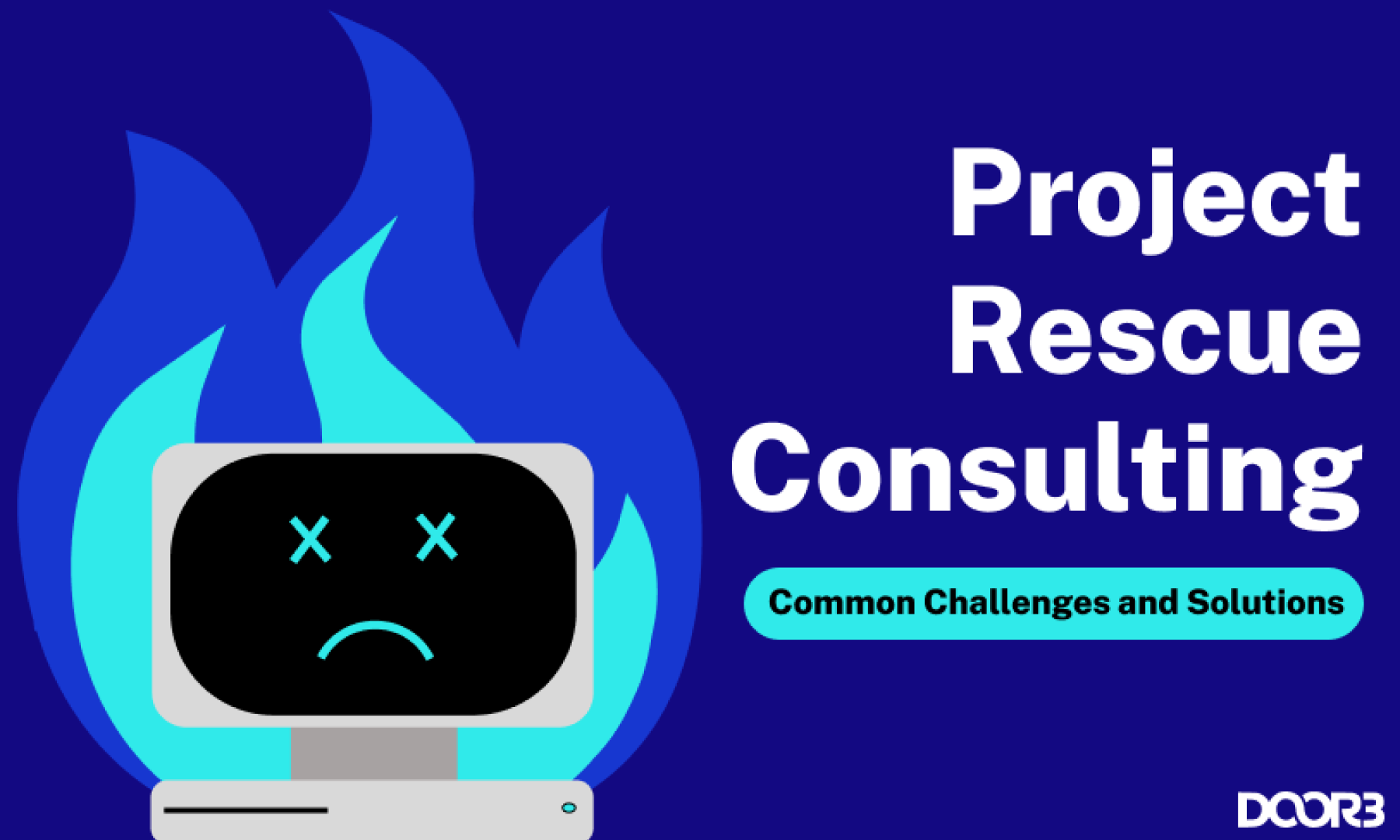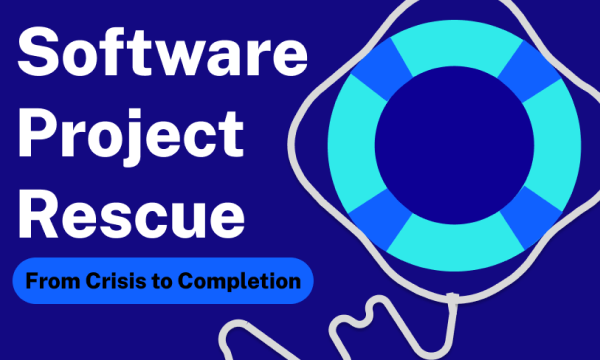Software Project Failure: Tips To Rebuild Your Failed Project
04.30.2024
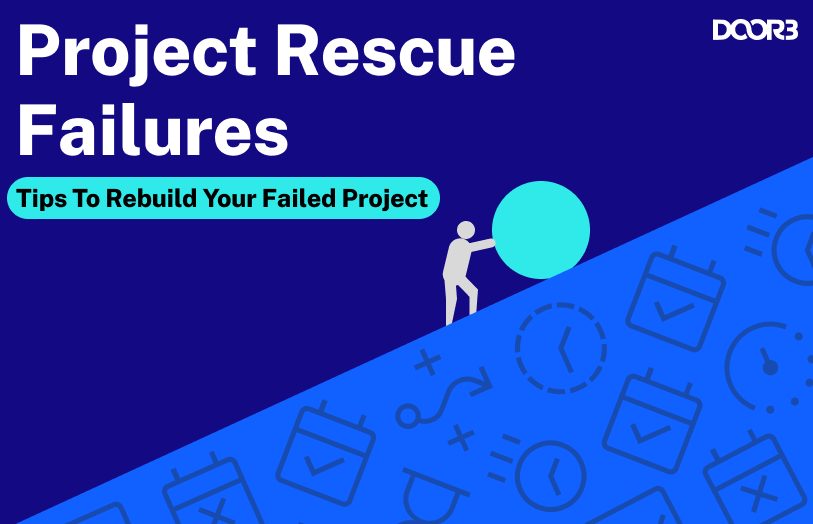
Understanding Software Project Failure
Software Project Failure does very little in its naming to hide what it entails. A Software Project Failure can be defined as when a software project does not meet its predefined objectives or fails to deliver value. Elements of Software Project Failure may include an overblown budget, missing deadlines, or a development team exiting before the project is completed.
A Software Project Failure can have huge implications for an organization, including the following:
-
Reputational damage
-
Financial loss
-
Legal or compliance complications
-
Impact on operations
-
Impact on morale
Each of these points can have major impacts on an organization’s ability to operate, and sometimes depending on the scale can cause severe damage or even bankruptcy.
So if Software Project Failure is so risky for organizations, how often does it occur?
While it can be difficult to analyze the breadth of Software Project Failure statistics or the Software Project Failure rate, there is a de facto authority on the success rate of software projects, known as the Chaos report. The research shows that the Software Project Failure rate is a shocking 31.1% of IT projects, and 52.7% of these same projects will cost 189% of their original estimates. That is not a Software Project Failure rate or the Software Project Failure statistics that excite stakeholders.
Let’s walk through how we can navigate through the Software Project Failure rate to avoid becoming part of that 31%.
What are the major Software Project Failure factors?
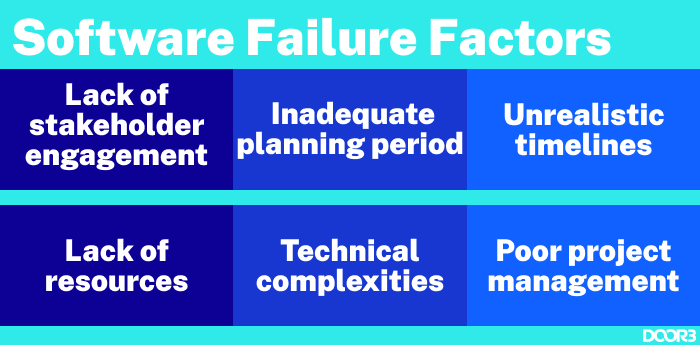
There are a lot of factors that can result in a software development failure, which you can read more about in our blog Project Rescue Consulting: Common Challenges and Solutions. But what are the major Software Project Failure factors? Generally factors behind Software Project Failure examples include the following:
-
Lack of stakeholder engagement
-
Inadequate planning period
-
Unrealistic timelines
-
Lack of resources
-
Technical complexities
-
Poor project management
These six factors are the most common reasons we see companies experience Software Project Failure, and each of these factors contains the nuance of the project they’re attached to.
Crafting success strategies
Turning a software development failure into a success story requires a diligent effort and a team that can lead you through the recovery process. It’s important to understand that effective software development is built off a few key elements.
Before writing a single line of code, requirements and scope must be crystal clear, and the role of project management in Software Project Failure is to know how to effectively lead their team through those requirements. All of this requires careful planning and a focused team of consultants, developers, and stakeholders.
Speaking of stakeholders, they must be engaged in the project, receiving all pieces of relevant communication in a direct and transparent manner. Projects with distant stakeholders very commonly lose their sense of direction and motivation, as stakeholders should be the project’s most active decision makers.
DOOR3’s approach to addressing Software Project Failure examples is broken into three phases:
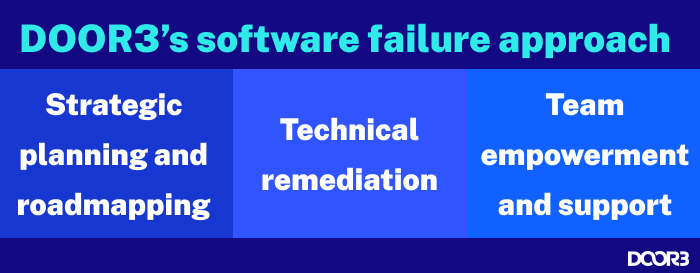
Working clients experiencing Software Project Failure through this process allows us to stabilize any operationally integral failing softwares, gain a holistic understanding of the project itself, and remediate its technical debts to reimagine your solution at its most effective capacity.
The power of our technical discovery process cannot be overstated. This comprehensive assessment provides all the critical information necessary for building a successful solution. Very often Software Project Failure is a result of the lack of information that this process elevates to the surface.
DOOR3 takes an Agile approach to our software development projects. Why? Because Agile allows us to most actively engage the stakeholders of the software project. Constant feedback loops and iteration helps to assure that the work we are doing is bringing the Software Project Failure closer to its original intention.
Software Project Failure case study: transforming failure into success
Our work with Pepsico is a powerful example of a Software Project Failure case study and how Software Project Failure examples can lead to a new and exciting solution to a business challenge. While Pepsico can certainly handle implementing out of the box solutions, the team saw an opportunity for something bespoke and exciting after the initial efforts to create a Power BI dashboard didn’t land the way they had hoped.
Cue DOOR3, who jumped in immediately to first conduct a discovery phase. We did not have to stabilize infrastructure in this case, as the Software Project Failure was not operationally relevant, this allowed us to spend even greater time mapping and strategizing a solution that would serve Pepsico the strongest.
The final product was a clean and crisp dashboard for data visualization. Our user-centric approach both met the needs of the client as well as set a foundation for future expansions and use cases for the solution. The end result of this Software Project Failure case study left the team wondering that if this is what happens after experiencing Software Project Failure, then maybe we should fail more often.
Avoiding pitfalls and minimizing risks
Being aware of the traps in software development help to reduce the risks of Software Project Failure. There are a few surefire ways to minimize the risk of software failure before you begin developing your project.

These elements under a competent project manager help to reduce the risk of software development failure. Project managers play a critical role here as well, and can also support solution development through utilizing Agile methodologies as well as engaging in risk management planning. Proactive leadership paired with skillful resource allocation leave more room for recovery if something goes awry.
Leverage DOOR3’s Recommendations for Proactive Risk Mitigation by reading our blog: Risk Management in Software Development: 7 Common Risks.
Selecting the right partner for rescue
When it comes to selecting a rescue partner after a software development failure, Consider these questions:
-
What experience does this company have with software project rescues?
-
What is their technical expertise? Is it relevant to my solution?
-
Can they reference previous success stories and do they have client testimonials?
-
Does their culture appear to align with ours?
-
How do they communicate? Is it direct and responsive?
Companies should also consider methodological matching and resource availability when looking for a software rescue partner. A good match should be able to answer all these questions and be cost effective.
Of course, when you partner with DOOR3 you can skip the selection process knowing you’ve made the right decision.
DOOR3’s expert assistance
With over twenty years of experience, DOOR3 is no stranger to bringing back projects at the brink of death. Our comprehensive range of technical capabilities, Agile and adaptive approach, and fantastic communication skills set us apart from the rest of the crowd. Our experts offer tailored solutions and support depending on the unique needs of your company, and with our proven record of success, we feel confident that we can handle whatever you throw our way.
Want to learn more? Contact us today, and let’s turn your Software Project Failure into your biggest success.
FAQs

1. How does DOOR3 approach cultural and organizational challenges in failed projects?
DOOR3 addresses cultural and organizational challenges by fostering collaboration, promoting transparency, and facilitating change management processes. Consultants work closely with stakeholders to understand organizational dynamics and implement strategies that align with the company culture.
2. Can DOOR3 assist with projects that have experienced multiple failures or setbacks?
Yes, DOOR3 has experience in rescuing projects that have faced multiple failures or setbacks. Consultants conduct thorough assessments, identify root causes, and develop targeted strategies to break the cycle of failure and achieve successful outcomes.
3. What is the role of project management in Software Project Failure recovery?
Project management plays a critical role in project rescue efforts by providing leadership, direction, and accountability. DOOR3’s project managers oversee the implementation of rescue strategies, manage resources effectively, and ensure alignment with project goals and objectives.
4. How does DOOR3 ensure continuity and sustainability after the completion of a project rescue engagement?
DOOR3 prioritizes knowledge transfer, documentation, and training to ensure continuity and sustainability after completing a project rescue engagement. Consultants work closely with client teams to transfer skills, best practices, and lessons learned, empowering them to maintain project momentum and success.
5. What measures does DOOR3 take to address stakeholder resistance or skepticism during project rescue efforts?
DOOR3 addresses stakeholder resistance or skepticism through proactive communication, stakeholder engagement activities, and transparency in decision-making processes. Consultants work to build trust, manage expectations, and demonstrate the value of proposed solutions to gain stakeholder buy-in and support.
6. How does DOOR3 adapt its approach to project rescue for different industries or sectors?
DOOR3 tailors its approach to project rescue based on the specific requirements, constraints, and regulations of different industries or sectors. Software Project Failure examples vary company to company, and DOOR3 consultants leverage industry-specific expertise, best practices, and standards to develop customized solutions that meet the unique needs of each client.
7. Can DOOR3 assist with projects that have undergone significant scope changes or requirements volatility?
Yes, DOOR3 has experience in rescuing projects that have undergone significant scope changes or requirements volatility. Consultants conduct thorough requirements analysis, manage scope creep effectively, and implement change management processes to ensure project success.
8. How does DOOR3 ensure alignment with emerging technologies and trends in project rescue efforts?
DOOR3 invests in continuous learning, research, and development to stay abreast of emerging technologies and trends in project rescue. Consultants leverage innovative solutions, tools, and methodologies to address evolving challenges and deliver value to clients.
9. What are the ramifications of failure in software project development?
Failure in software project development can lead to various consequences, including financial losses, damage to reputation, loss of customer trust, missed market opportunities, and negative impact on stakeholder morale. Additionally, failed projects may result in wasted resources, missed deadlines, and increased project costs.
10. What strategies can be employed to mitigate the risk of what are the major Software Project Failure factors?
To mitigate the risk of software development project failures, organizations can implement several strategies. These include thorough project planning and risk assessment, clear communication and collaboration among stakeholders, setting realistic project goals and expectations, utilizing agile methodologies for flexibility and adaptability, conducting regular progress evaluations and course corrections, and investing in skilled and experienced project management and development teams.
11. How does a software project manager need to act to minimize the risk of software failure?
A software project manager needs to institute rigorous requirements, realistic scheduling and budgeting, continuous stakeholder engagement, and quality assurance. These elements under a competent project manager help to reduce the risk of software development failure.
12. Can you provide some examples of Software Project Failure examples?
Some recent examples of software development failures include the launch of a widely anticipated mobile application that experienced significant technical glitches upon release, resulting in widespread user frustration and negative media coverage. Another example involves a software update for a popular operating system that caused system crashes and data loss for users, leading to widespread complaints and customer dissatisfaction. These instances highlight the importance of thorough testing, quality assurance, and risk management in software development projects.
13. Does DOOR3 have additional Software Project Failure case study materials?
Yes, DOOR3 has additional Software Project Failure case study materials. Please contact us to set up a consultation.
Think it might be time to bring in some extra help?
Read these next...

Request a free project quote
We will review your request and provide a project cost assessment within 1 — 2 working days.
Request a free project quote


